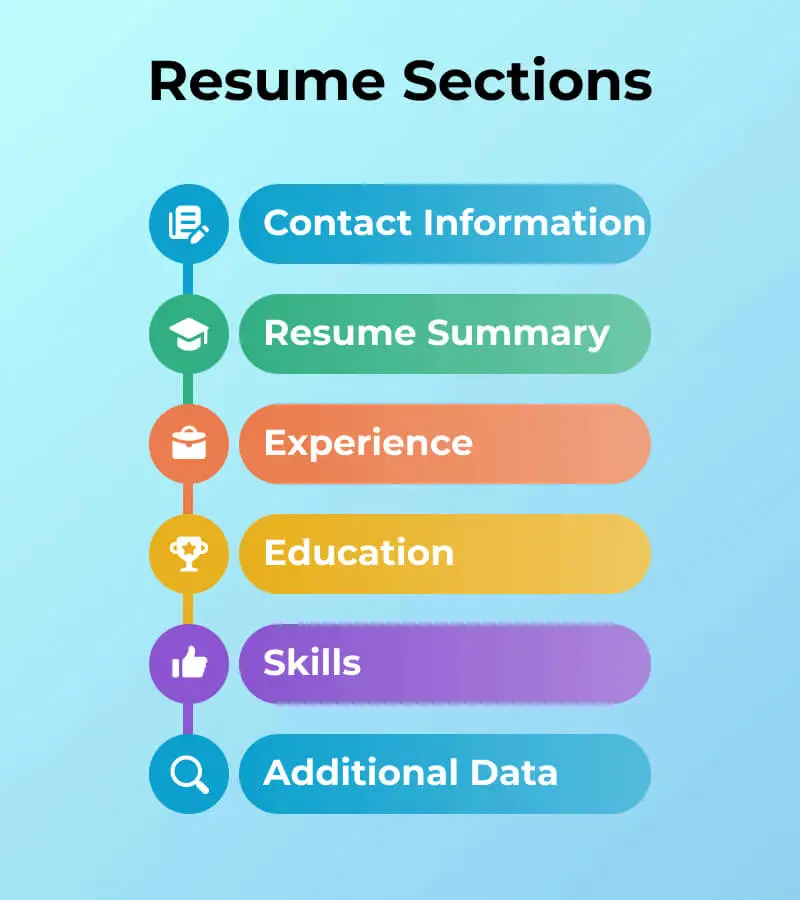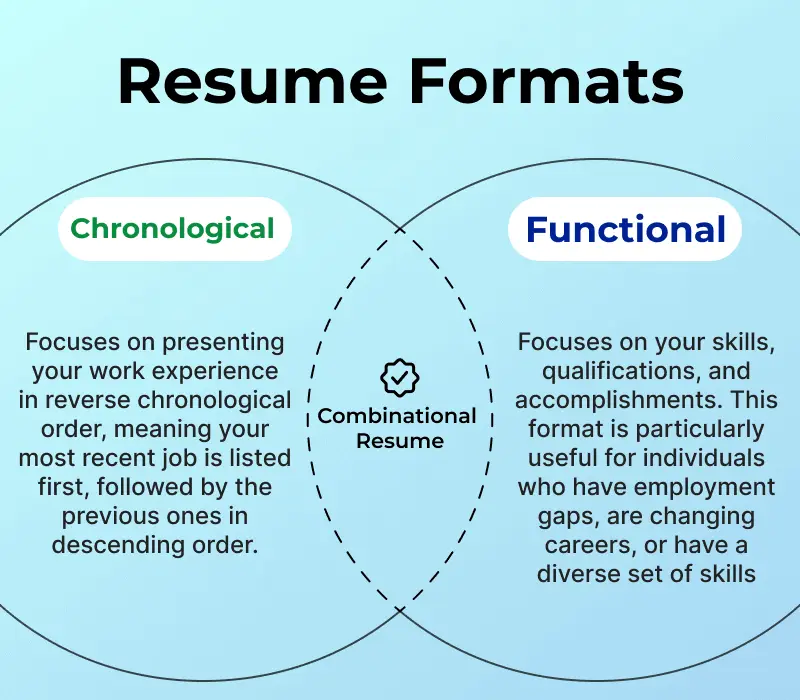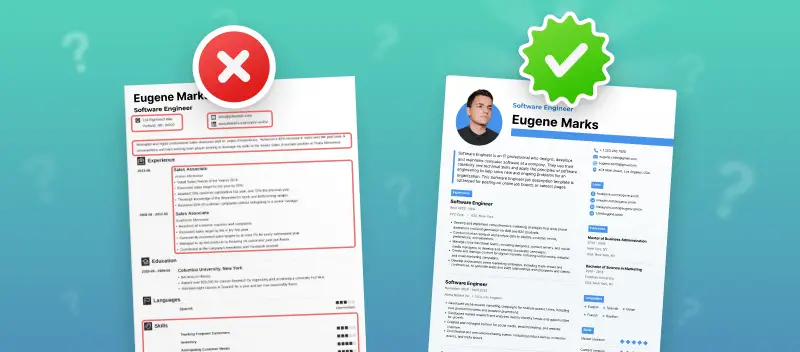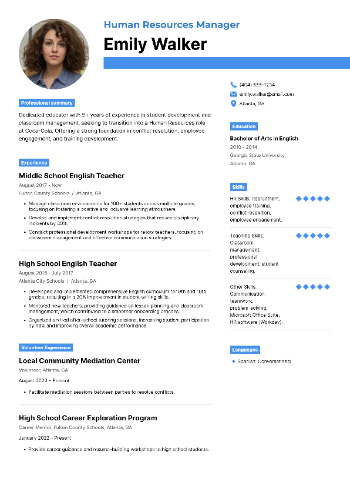How to organize a resume? What resume sections are compulsory? Writing a resume can seem daunting. But don't worry; it's easier than you think.
Breaking down the resume into smaller sections can make the process more manageable. Moreover, it ensures that your resume is organized and formatted correctly.
In this article, we'll cover the basics of a resume and discuss each of the main sections.
What Should Be on a Resume
A typical resume should contain various sections to aid employers in swiftly analyzing applicants' qualifications and experience. These comprise:

Mandatory Resume Sections
A well-structured resume typically includes several key sections that provide a comprehensive overview of your professional background, skills, and qualifications.
While the exact format may vary based on your industry or personal preferences, below are the common and often considered mandatory resume parts.
Always include:
- Contact Information: Full name, phone number, email address.
- Resume Objective or Summary: A brief statement highlighting your career goals, skills, and what you bring to the table.
- Professional Experience: List your work experience in reverse chronological order.
- Education: List your educational background in reverse chronological order.
- Skills: Create a resume section that highlights relevant skills, both hard and soft skills.
Look at the resume example that contains only mandatory resume sections:
Supplementary Resume Sections
There are many optional resume categories you can add to your resume, providing extra detail and enhancing the likelihood of securing employment.
Include if needed:
- Awards and Certifications: Showcase any relevant certificates, such as software, language, or professional development.
- Languages: If you possess fluency in multiple languages, list them here.
- Publications: If you're a writer, list any published works you have.
- Volunteering: Record your experience, such as pro-bono work or charity events.
- Hobbies and Interests: Add extracurricular activities pertinent to the vacancy you are applying for.
- References: Attach letters of recommendation from your past colleagues.
Regarding alternative resume sections, it pays to be judicious and only include those connected to the job opportunity. This will secure your resume being adapted to the role, assisting you to be noticed among other applicants.
This is an example of how a resume with additional sections would look like:
To remember all the details, it is better to use an online resume generator. Thanks to its resume templates, you will never miss any important resume section or encounter any formatting problems.
Just fill in the mandatory sections, add optional ones, and you are done. In addition, the implemented AI writer would help you draft the "Professional summary" and "Experience" sections.
Create your professional Resume in 10 minutes for FREE
Build My Resume
How to Order Resume Sections
Properly listing your sections on a resume can help capture the interest of HRs and create an impactful introduction.
- Begin with your contact information. Start your resume with your name, phone number, email address, and LinkedIn profile (if applicable). This makes it easy for employers to get in touch with you.
- Follow your contact information with a brief resume objective or summary that provides a snapshot of your skills and career goals.
- List previous work experience, beginning with your most up-to-date job and moving backward. Insert job titles, company names, dates worked, and a summarized explanation of duties at each position.
- Point education in addition to professional experience. List educational institutions attended, degrees earned, and relevant coursework or certifications received.
- Remember any extra skills or qualifications that would be of value to an employer. These could consist of foreign language proficiency, professional communication skills, or any other special qualifications you have that could set you apart from the rest. You can categorize them into technical skills, soft skills, and any other pertinent categories.
- After skills come any applicable awards or honors you have received.
- Finally, come any professional affiliations you may have, such as memberships in industry organizations or committees you've served on.
Now, let's have a closer look at the sections to include on a resume.
Parts of a Resume
Contact Information
When drafting your resume, contact information is among the paramount components of a resume. This area should include your full name, address, email, and phone number.
- Guarantee that your contact data is up-to-date. Your prospective employer will need this information to contact you for an interview or any other questions they may have.
- Create a new email that uses your full name. This will be advantageous for employers to remember and identify you. Also, avoid utilizing nicknames or numbers in your address. For example, instead of "partyanimal@gmail.com," use "janesmith@gmail.com."
- Make sure to check this email account regularly. If employers try to reach you, they must ensure they're receiving a timely response.
- When you provide your email, make sure you type the domain name, too.
- Your phone number must be one you are comfortable with a potential employer calling. If you don't want to use your personal cell phone number, consider setting up a Google Voice account or using a VoIP service like Skype.
- Ensure that you check your voicemail frequently. It's also important to answer calls from unknown numbers.
- Ultimately, be mindful of any country codes that might be essential when adding a phone number to your resume. If you're applying for jobs overseas, ensure the prospective employer knows how to dial you correctly.
Name
Writing your name correctly is one of the important aspects of resume writing. It's the first thing employers and recruiters will see. Here's how to write your name in this resume section:
- Start with your first and last name at the resume headline, centered between the margins.
- If you have a middle name, insert that as well.
- Add any other names you go by professionally, such as a maiden name or nickname.
- If you're including a professional headshot, be sure to include the name in a small type so it's visible but not distracting.
Following these steps will help guarantee that recruiters can find all of your pertinent contact information quickly and easily when looking over your resume.
Home Address
Your home address is your physical location, and it helps employers ensure that you are reliable and responsible.
- It should be listed as a single line of text without extra symbols or punctuation. Just write the street number, name, city, province/state, and postal/zip code. For example: "123 Main Street, Toronto, ON, M4G 5T6".
- It's best to present your current address if you have moved recently. This will show employers your expertise in securing a permanent residence. If you have lived at more than one address in the last years, list them chronologically in a separate resume section.
- If you are from another country, display "International" as your residence. Note it on all job applications - not just those for jobs outside your country. This will help employers understand that you are willing to move if needed.
LinkedIn Profile and/or Website (optional)
This resume part allows employers to instantly unearth supplemental data about you, such as your work experience and education. It also assists employers to gain insight into your professional accomplishments and career goals.
Mentioning a website showcases your technical expertise, especially if you apply for a tech-related or a technician job. Moreover, it provides employers with a quick and easy way to connect with you.
Ensure that:
- The information featured on your web presence is up-to-date and relevant to the career you are pursuing.
- The content you share reflects positively on you as a professional.
- Profile illustrates terms related to the occupation, as this helps employers find your account.
- All URLs are functional and lead directly to the intended pages without requiring additional navigation.
Inserting a link to an online portfolio or LinkedIn page in your resume can give employers an extra boost of confidence in hiring you. Make sure that it showcases all your best qualities as an applicant and that you keep it updated!
Resume Summary and Objective
These are two sections of a resume that are important. A summary presents employers with an outline of experience, skills, and expertise. An objective is a statement of professional goals and what they hope to gain from the position.
| Resume Summary Section | Resume Objective Section |
|---|---|
| A short paragraph summarizing the most important qualities that make the candidate stand out. Usually placed at the top. | Succinct expression of the contestant's professional ambition. |
| It must include years of experience, education, certifications, specializations, and other details to help the employer quickly learn about you. | Should not be general or too vague, but rather should explain the position they are looking for. Should also mention what skills and experiences would benefit the employer. |
Both resume sections must be tailored to every job opportunity to reflect the job seeker's unique qualifications and accomplishments successfully.
Work Experience
Your work history resume section is the most crucial part of your resume. It should be customized to the position you're vying for and draw attention to your most pertinent and noteworthy successes.
- Job Title and Company Name: List the role along with the organization name.
- Dates Employed: List your position's start and end dates.
- Responsibilities: Describe the tasks and duties you handled during your employment.
- Achievements: Highlight any awards, promotions, or accomplishments demonstrating your skill and success.
- Skills Used: Ensure to outline any aptitudes you employed on the job that could be helpful for future employers.
Remember to keep this resume section concise and focus on relevant information that pertains to the role. Your experience section must be personalized to each application so that it precisely depicts all of the best parts of your professional history!
Including numbers and measurable achievements in the "Professional Experience" resume section can significantly enhance your resume. According to a study by ResumeGo, resumes with quantifiable accomplishments were 40% more likely to receive interview requests than those without specific numbers.
Education
A carefully constructed education resume section includes name and location, degree, major, minor, year graduated, and honors or distinctions.
- To get started, begin with your most advanced qualification. Add all other degrees in descending date order after that. If you have multiple degrees from the same institution, list them separately.
- If you're still in school and don't have a degree, incorporate your anticipated graduation date and courses in progress. You can also list classes you've taken applicable to the job.
- Make sure to highlight any honors or awards you have received. This could be scholarships, fellowships, or academic awards such as Dean's List recognition. It's also good to mention any relevant organizations or clubs you were involved with in school.
- Display your GPA if it’s strong (typically 3.5 or above), especially for entry-level positions or recent graduates.
A well-written education section tells employers you have the skills to do the job and helps them learn about your background and experience.
Build a Resume Now!Skills Resume Section
Your skills section is a key component of your resume. It must be concise and to the point, denoting your knowledge and abilities in a few sentences. The following are suggestions:
- Highlight soft skills such as communication, problem-solving, and teamwork.
- Include hard skills, such as knowledge of a specific software program or expertise in a particular area.
- Use language from the job description when applicable.
- Tailor your list of skills to each job you apply for.
- Utilize action verbs when describing skills.
- Keep it brief: no longer than six bullet points.
References
This resume section provides HRs with the contact information of individuals who can endorse you as a professional.
Here are some tips:
- Choose carefully. Select recommenders who are familiar with your work and accomplishments. They should be able to speak positively of you and your skills.
- Include contact information. List each reference's name, title, company name, email address, and phone number.
- Be consistent. Use the same formatting for each reference's contact information, such as italicizing titles or bolding last names.
- Keep it short. Limit your list of references to 3-5 people who can best speak to your qualifications for the job you're applying for.
- Ask permission first. Before including someone, make sure they're willing and available to talk to potential employers on your behalf.
- Make sure it's up-to-date. Ensure that all references' contact details are up-to-date and correct before submitting your resume for consideration.
Certifications Resume Section
Including a "Certifications" section on your resume can provide a competitive advantage. LinkedIn reported that professionals who display certifications on their profiles receive, on average, six times the number of profile views.
It provides evidence of additional qualifications and expertise that will aid the employer in deciding to hire the individual.
- The section should be located near the top, right after the academic resume section. This is because it's one of the first things employers look for when deciding whether to contact a candidate.
- The certificates chosen should be pertinent to the specific job being applied for. For instance, if applying for a software engineering role, put certifications related to coding or programming languages.
- Demonstrating licenses on a resume indicates to prospective employers that the applicant is proactive and dedicated to their professional growth. This can illustrate dedication to career growth and help make a strong impression on employers.
Hobbies and Interests
Hobbies and interests add color and substance to your resume. They show employers that you are an interesting person with various skills and experiences.
Here's how to include hobbies and interests:
- Consider which ones most strongly align with the role you're seeking.
- Make sure you have at least one hobby or interest listed on your resume.
- Write a brief description, such as how long you've been interested in it, what aspects you enjoy most, and why it's important to you.
- If possible, mention any unpaid work or extracurricular activities related to your hobbies or interests.
- Utilize dynamic terminology to illustrate your hobbies and interests. For example, if you enjoy playing tennis, write "Competitive Tennis Player" instead of just "Tennis Player."
- List those that show off a positive quality or skill.
- Choose activities that can spark conversation in an interview and provide insight into your personality.
Hobbies and interests should not take up too much space – one or two lines are enough. However, they can be important if they demonstrate characteristics specific to the occupation.
Social Network
Start by separating each of your social networks into its own section. This will make it easier to see which platforms you are active on quickly. Label each resume section with the name of the network.
Add URLs to your accounts. This allows employers to click the link and view your profile easily.
Finally, consider including some recent examples of posts or content you have created on the platform. This is an excellent method for showing off your creativity and understanding of the platform.
Create your professional Resume in 10 minutes for FREE
Build My Resume
What Not to Put on a Resume
While it's essential to add relevant information to your resume, there are certain things you should avoid including.
Don'ts:
- Do not specify personal details such as your age, marital status, religion, or social security number.
- Never incorporate false information or exaggerate your qualifications on your resume.
- Avoid using negative language or information that may raise red flags for employers.
- It's generally not necessary to place salary expectations on your resume. Save this discussion for later stages.
- Refrain from listing unrelated or potentially controversial hobbies.
- Try to eliminate clichés and overused phrases in your resume.
- Limit the number of personal pronouns you utilize, such as " I", "me", or "my".
- Skip noting outdated technical skills or software no longer relevant.
Picture on Resume: Pros and Cons
Including a picture on your resume can be a contentious topic. While common in some countries and industries, it's frowned upon or even discouraged in others.
In countries like Germany and Japan, it is common practice to include a photo on your resume. Similarly, in industries such as modeling, acting, and hospitality, a professional headshot is expected as part of the application.
Understanding the advantages and disadvantages can help you decide whether adding a picture is the right choice for you.
Pros:
- Personal Touch. A photo can humanize your resume, helping potential employers put a face to your name. This is especially important in creative or customer-facing industries where personal presentation is key.
- Memorability. In a stack of resumes, a photo can make yours more memorable. Recruiters are more likely to remember candidates with faces, which can give you an edge in the selection process.
- Initial Impression. A professional, well-chosen photograph can convey a strong first impression. It can demonstrate your professionalism, confidence, and approachability before you even step into an interview.
Cons:
- Bias and Discrimination. Recruiters might make judgments based on your appearance, which can lead to discrimination based on age, race, gender, or attractiveness.
- Legal Issues. In some countries, anti-discrimination laws discourage or even prohibit the inclusion of photos. Employers in these regions might reject resumes with pictures to avoid legal complications.
- Focus on Qualifications. Including a photo can detract from your skills and qualifications. Employers should be focusing on your experience, education, and abilities rather than your appearance.
In conclusion, while a picture can personalize your resume and make it stand out, it's important to weigh the potential risks. Evaluate your industry standards and local regulations to ensure your document aligns with them.
If including a photo is appropriate for your industry and location and you decide to include one on your resume, ensure it’s a high-quality, professional headshot. Avoid casual photos, group pictures, or anything too flashy. A simple, well-lit photo with a neutral background works best.
Formats of the Resume
When it comes to resume sections, the format is just as important. You want to make sure you use a comprehensible format that emphasizes your best qualities. These are the most popular resume templates formats:

- Chronological. This is the most common format. It lists your work history in reverse chronological order, beginning with your current job.
- Functional. Emphasis is placed on your capabilities and credentials rather than your past employment. It is advantageous for those with breaks in their job history or transitioning to a new career.
- Combination. As the name suggests, this format combines elements of chronological and functional resumes. It's a good choice if you need to highlight specific skills and experiences while still listing your history.
- Targeted. This format is tailored to a specific job or industry; it emphasizes the skills most relevant to the employer's needs.
According to a study by TheLadders, recruiters spend an average of 6 seconds reviewing a resume, and a reverse-chronological format allows them to assess a candidate's recent work history quickly.
Personalize the Resume Parts
How can you make sure your sections of a resume stand out?
One approach is adding some "spice" to the resume sections.
- Start by getting creative with the resume section titles you use. Instead of standard titles like "Work Experience" or "Education," opt for something more unique and eye-catching.
- Once you have interesting section headers, now is the moment to focus on the content. Use powerful action words, such as "initiated," "spearheaded," and "developed." This will showcase and demonstrate your accomplishments in an impactful way.
- To add some flair to your resume, consider using bullet points instead of long paragraphs to break up the text. This simplifies the ability to scan through information quickly. You can also use bolded words, italics, or underlining to highlight essential particulars.
- Finally, thoroughly check your resume and cover letter before handing it in. Check spelling, grammar, and punctuation errors so that your document looks professional.
With these simple tips, you can give your resume sections some extra spice and ensure they are prominent and stand out!
Level-Based Resume Organization
| Graduates | Experienced Professionals | Career Changers |
|---|---|---|
| If you recently graduated, start writing resume with your education section. Include details such as degree, program, GPA, and any awards or scholarships received. | If you have several years of experience, begin with a summary and skills. This is where you can showcase your most relevant accomplishments and qualifications in an easy-to-scan format. | Consider using a combination resume format. By outlining a summary or skills set relevant to the new career. |
| List your experience section, if applicable. If you don't have any professional experience yet, highlight any internships or volunteer work demonstrating relevant skills. | Follow this with a resume section that outlines your background. Include your past jobs and any promotions or awards you've earned. Detailed information on job duties as well as results achieved. | Follow up by displaying pertinent experience from prior positions or volunteer activities. |
| End with a skills section to highlight any specialties or certifications. | Finally, add an education block at the end. Remember to arrange it in chronological order and include the institution's name, the years attended, and the degree earned. | Revise an education section and find classes applicable to the new position you're seeking. |
The "Education" resume section is important, especially for recent graduates or candidates in academia. The National Association of Colleges and Employers (NACE) reported that 78% of employers preferred candidates with a bachelor's degree or higher.
Here are resume section examples for each experience level:
Regardless of your career stage, think carefully about the order of sections to ensure they reflect your unique background.
How to Divide Resume Components
The key to an easy-to-read document is the separation of resume sections.
For dividing up your resume, there are a few different ways to approach it.
- The simplest one is to use a bold font for all the headings. This will streamline recruiters' process to scan your document quickly.
- You could also split your resume by using horizontal lines or even adding boxes around various sections. Doing this can help break up the page.
- An alternate choice is to apply color to distinguish sections. It's important not to go overboard with colors, though - try and keep it subtle and professional.
- Finally, another way of breaking up resume sections is by using indentations or bullets.
In conclusion, there's no single method to separate parts of a resume; experiment with different ways until you find one that works best for you.
Resume Examples
DOC vs PDF
One of the key decisions when submitting your resume is which file format to apply.
Typically, you'll be asked to submit a DOC or PDF file. Which one should you choose? Let's check the differences between the two formats.
| DOC | |
|---|---|
| Traditional format for Microsoft Word documents. It contains text, formatting, images, and other elements that make up the document. This format is easily editable and is accessible on any device with Microsoft Word installed. | Can be opened on almost any device without requiring additional software. They also have the advantage of being read-only, meaning they cannot be changed without unlocking them first. |
| Not secure and may contain viruses or other malicious software, making them less desirable for employers. | More visually appealing as they preserve fonts, formatting, and layout exactly as intended by the author. This makes them ideal for resumes as they maintain the original design of your document. |
Which choice should you make? While both formats have pros and cons, PDF files are usually considered the better selection due to their security and visual appeal. They allow your resume to shine compared to other applicants while also keeping it safe from potential threats.
Video Resume
Video resumes are becoming increasingly popular in the job market. A video resume is a short video clip that allows you to present yourself in a more engaging way that a traditional resume templates cannot.
This can serve as used to showcase your credentials, skills, and personality. Here is the procedure for constructing a successful video resume:
- Explore video resume standards. Take a look at examples of video interviews.
- Research what recruiters want to see in your video resume. Look up job postings in your field and double-check to add relevant information they are looking for.
- Prepare an outline of what you want to say. This guidance will assist you in presenting yourself effectively and ensuring that the video does not exceed two minutes.
- Make sure you have good lighting and sound quality for the video. Poor sound or visuals can be distracting and take away from the message you are trying to convey.
- Practice your script several times before recording so that you feel comfortable recording the resume.
- When recording, make sure you're looking directly at the camera and speaking confidently and clearly about your qualifications and experiences.
- Once you have recorded the video, edit it to two minutes or less and add captions if necessary for clarity.
When to use a video resume
A video resume is especially helpful when applying for positions in creative industries like marketing, media, or design. It can also give you an edge over other applicants when competition is fierce with a large pool of candidates for the same position.
According to a resume study by TheLadders, the top half of your resume is the most critical section, as recruiters tend to focus on this area during their initial review. Ensure that the most relevant and impactful information is placed in this resume section.
FAQ
- Can I omit certain sections if they are not relevant to the job?
- Yes, for example, if you're applying for a technical position, say of a software developer or software engineer, you might not need to include a part for volunteer experience.
- How can I make sure my resume sections are easy to read?
- Use clear headings, consistent formatting, and bullet points to break down information. Keep the font simple and legible, and ensure there is enough white space between blocks for easy navigation.
What Goes on a Resume: Conclusion
The components of a resume depend on the job requirements and your individual experience. The optimal path forward is commencing with fundamental facts about yourself and then constructing upon that.
By adhering to these directions, you can construct a well-structured resume that creates a positive initial impression. Make your resume stand out with an easy-to-understand organizational structure.
Create your professional Resume in 10 minutes for FREE
Build My Resume























